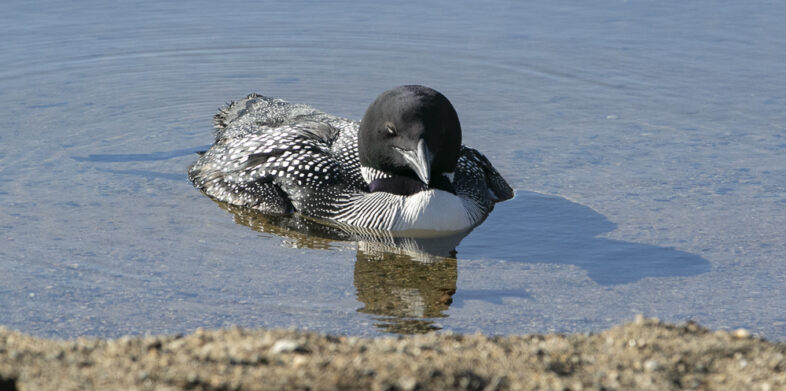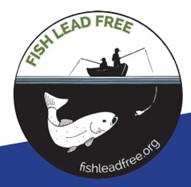Vermont’s loon population has experienced an incredible recovery largely due to highly coordinated, multi-faceted conservation efforts across the northeastern US.
However, despite a 2007 Vermont law regulating the size of lead sinkers anglers can use, fishing gear remains a prominent threat to loons in the Green Mountain State.
Every year, lead tackle and discarded monofilament lines are responsible for nearly 50% of loon deaths in Vermont. Beginning in the summer of 2023, VCE is spearheading an effort to reduce the amount of lead in people’s tackle boxes and clean up discarded fishing gear.

A lead-affected loon moments before rescue on Halls Lake in 2022. The loon died shortly after being retrieved. © Ian Clark
How does lead poisoning affect loons?
It only takes one lead sinker or jig to kill a loon. Once swallowed, lead weights dissolve in the loon’s gizzard and absorb into their bloodstream, causing lead poisoning. Affected loons can’t fly, may swim in uneven circles, and experience tremors. These effects limit the loon’s ability to avoid predators and eat, ultimately preventing it from mating, nesting, and raising young. Loons that experience these symptoms cannot be cured and typically die in about two weeks.
How do loons ingest lead tackle?
Many anglers use lead sinkers and jigs to get their fishing lines to sink; however, these weights can get lost when a line breaks or is cut to release a fish. Loons may then catch the injured fish, swallowing the lead along with it, or pick up weights along with gravel from the lake bottom. (Loons need to swallow gravel regularly to help digest their food.)
What are Vermont’s current lead fishing gear regulations, and are they working?
As of January 2007, it is illegal to use and sell lead sinkers weighing one-half ounce or less to fish in Vermont. Larger lead sinkers more than one-half ounce and lead jigs are still legal.
Between 2008 and 2018, VCE documented a threefold decrease in loon mortalities from
lead tackle. Despite this drop in lead-related mortalities, Vermont’s loons are still negatively impacted by lead tackle and other fishing gear. Since 2019, at least 10 loons have ingested lead fishing gear and died. That’s almost 3% of Vermont’s loon population.
Fishing lead-free is one of the best ways anglers can help protect Vermont’s loons.

Thankfully, plenty of lead-free alternatives exist, allowing anglers to continue enjoying their fishing expeditions with minimal risk to wildlife. These alternatives are made from non-toxic materials such as tin, bismuth, steel, tungsten, and ceramic, and are widely available. The price difference is minimal, often as little as 50 cents to a dollar.
These products are not only safer for wildlife, but they’re also safer for humans. Current research, especially with regard to children, suggests that there is no safe level of exposure to lead. Limiting the lead around lakes and households is in everyone’s best interest.
You can find an expansive list of non-lead tackle manufacturers and retailers on fishleadfree.org/vt/.
Starting in 2023, VCE will be working with lake associations and the Vermont Fish and Wildlife Department to set up a project to allow anglers to dispose of lead fishing gear that is still in their tackle boxes as well as a place to dispose of broken fishing line. We will be installing collection tubes across the state. Stay tuned as we finalize plans and locations so you know where to bring your lead. Fish lead free for the benefit of loons, waterfowl, and other wildlife.
What else can you do?
Besides switching to lead-free tackle, we also advise anglers to consider the following practices.
- Reeling in when loons are diving nearby since loons will take live bait and lures. We recommend using the 200-foot rule.
- Encouraging your family, friends, and local tackle shops to use and carry non-lead tackle. Many of these choices are available at a similar or slightly higher price compared to lead.
- Disposing your lead tackle (list of Vermont collection sites coming soon!).
- Picking up and disposing your monofilament line. Most monofilament line is not biodegradable and will last hundreds of years in the environment. Often discarded near the shoreline, monofilament line provides hazards to birds and other wildlife.
For more information, please contact VCE loon biologists Eloise Girard and Eric Hanson at .
